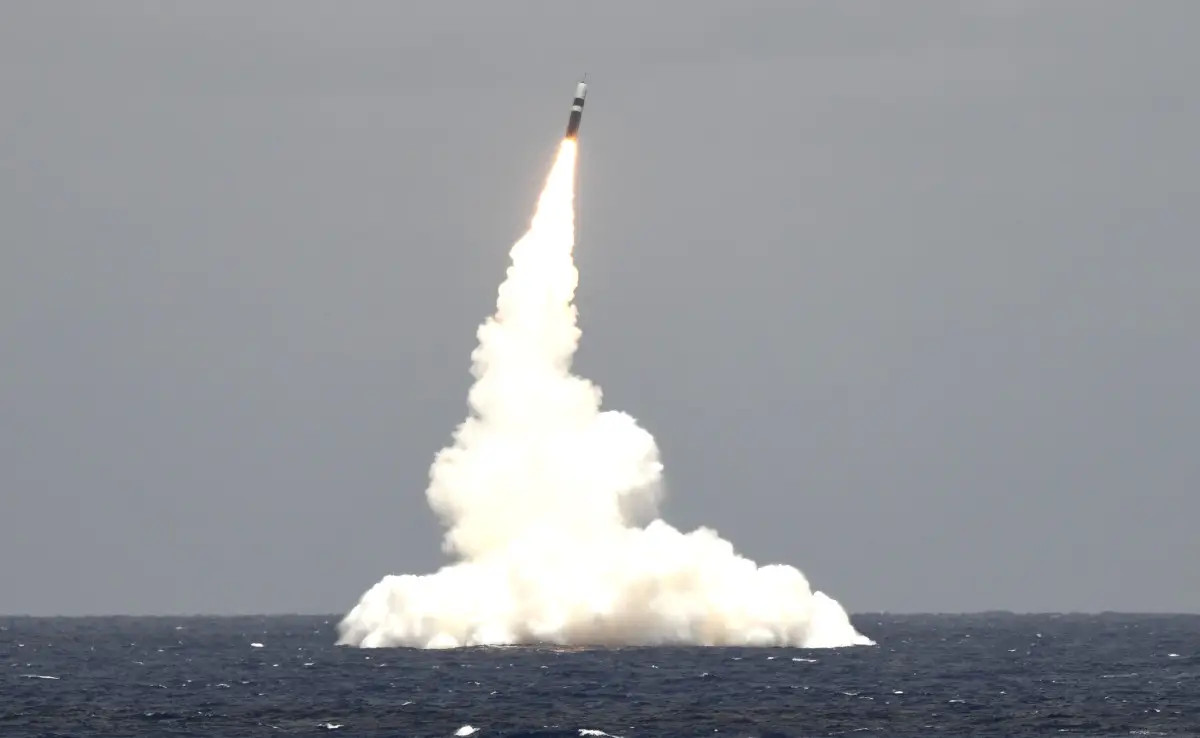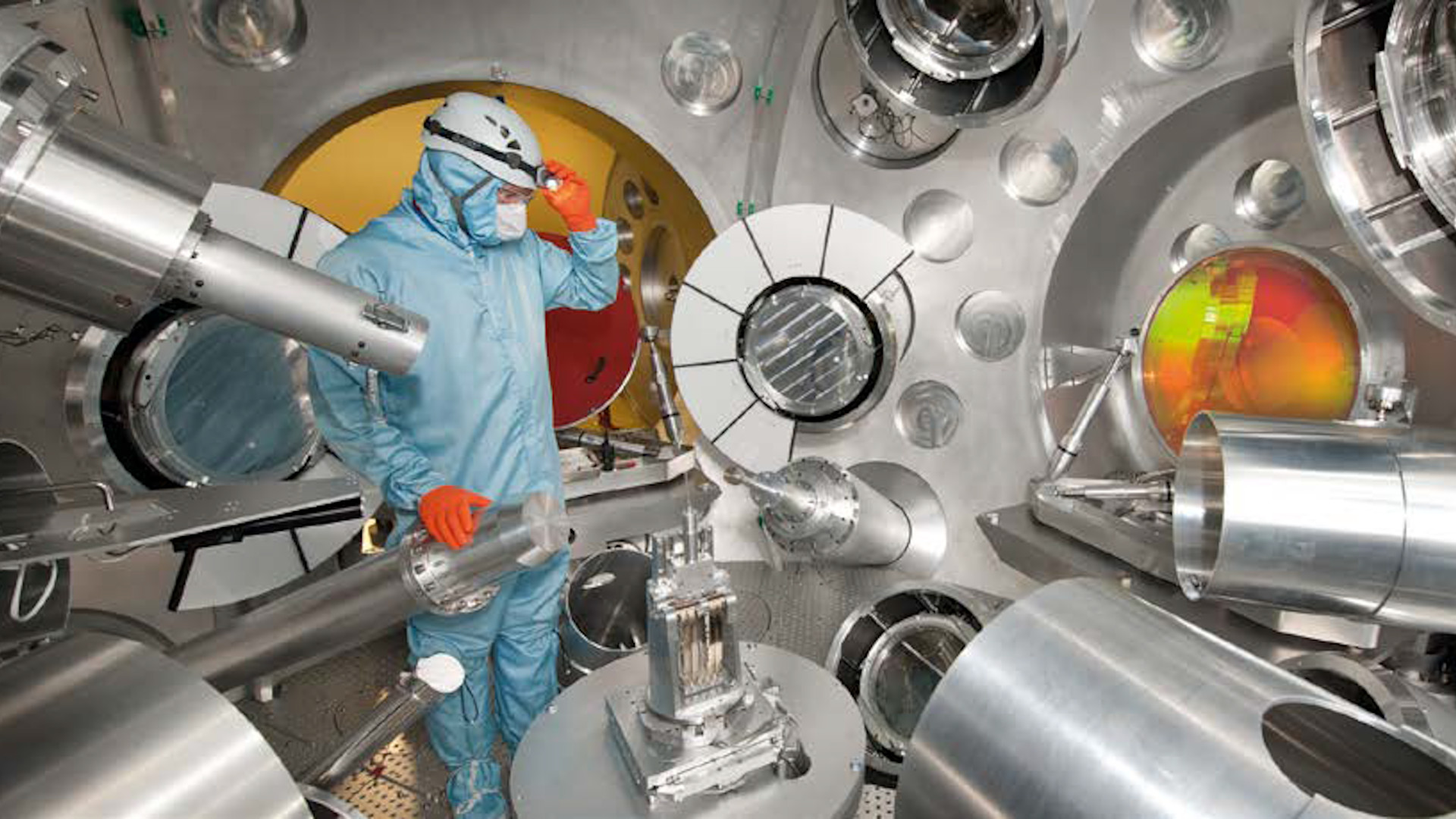The U.K. Ministry of Defense has shared details about how it plans to make sure its future A21 nuclear warhead works as intended without actually detonating one. Though this kind of testing is not new in concept, the British government says it has been expanding and improving its capabilities specifically to support work on its next-generation warhead. When ready, the A21s will go into U.S.-made Trident II submarine-launched ballistic missiles.
Information about the A21 warhead and related developments were included in a Defense Nuclear Enterprise Command Paper that the U.K. Ministry of Defense (MoD) released earlier today. The A21, which was previously known publicly simply as the Replacement Warhead Program, is also now called Astraea. Often translated as “star-maiden,” Astraea is the name of a minor ancient Greek goddess of purity and justice. The United Kingdom’s nuclear deterrent capability is currently made up entirely of four Vanguard class submarines capable of firing nuclear-armed Trident IIs. An equal number of new Dreadnought class boats is set to replace them replace the Vanguards in the next decade or so.

“The U.K. committed to replacing our sovereign warhead in parliament in February 2021,” according to the newly released MoD white paper. “Using modern and innovative developments in science, engineering, manufacturing, and production at AWE [the Atomic Weapons Establishment], we will ensure the UK maintains an effective deterrent for as long as required.”
British authorities say that the country’s existing stockpile is being maintained at least during the development of the A21. This could help explain the announcement in 2021 that the country’s total stockpile size would grow for the first time since the end of the Cold War. Work on the A21 is part of a multi-billion-pound effort to modernize the British nuclear enterprise as a whole. Just last year, authorities in the United Kingdom announced plans to invest another three billion pounds, or nearly $3.8 billion at the current rate of exchange at the time of writing, to support this overall effort, according to the white paper released today.
Details about the A21 are scant and its estimated yield is unknown. The MoD does say that the Astraeas will be loaded into Mk 7 re-entry vehicles, a new design that will also be used with the now-in-development U.S. W93 warhead, which we will come back to later.

The A21 “will be the first U.K. warhead developed in an era where we no longer test our weapons underground, upholding our voluntary moratorium on nuclear weapon test explosions,” the MoD’s new nuclear white paper says. “This is possible because of the long history of technical expertise and extensive investment in UK modelling and simulation, supercomputing, materials science, shock and laser physics at AWE.”
The British government voluntarily took up a policy position to end nuclear testing in 1995. The country signed the Comprehensive Nuclear-Test-Ban Treaty (CTBT) the following year and ratified that agreement in 1998. The U.S. government, which has a very close relationship with its British counterparts, including in the development of nuclear weapons, also has a voluntary moratorium in place against nuclear testing and has signed the CTBT, but has not ratified its participation in that treaty. China and Israel have also signed, but not ratified the CTBT, and Russia de-ratified its participation last year. India, Pakistan, and North Korea have never signed the treaty. Russia’s withdrawal from the deal has raised concerns about new live nuclear testing, but the Kremlin has insisted it will only do so if the United States does so first.
In the United Kingdom, “we have developed unique and world-leading technology to validate the U.K.’s warhead stockpile. The Orion laser helps our physicists and scientists research the physics of those extreme temperatures and pressures found in a nuclear explosion to better understand the safety, reliability, and performance of nuclear warheads,” the MoD’s white paper explains. “Orion is used collaboratively with U.K. academia and U.S. teams in their National Laboratories.”

“Supercomputing is also a crucial capability, enabling simulations that allow us to develop a safe, assured warhead without detonation,” the newly released document adds. “AWE has recently commissioned a supercomputer named Valiant, one of the most powerful computers in the U.K., to validate the design, performance and reliability of our nuclear warhead.”
A facility in France called EPURE, which British and French authorities operate together, will also support the A21’s development.
“EPURE is a technologically-advanced hydrodynamic facility at Valduc, in France, near Dijon. Hydrodynamic testing uses radiography to measure the performance of materials at extreme temperature and pressure,” according to the nuclear white paper. “While the UK and France maintain operational independence, the facility will be jointly managed, with both nations performing sophisticated experiments to inform their modeling of the performance and safety of the nuclear weapons without undertaking nuclear explosive tests.”

As noted, these kinds of nuclear test capabilities are not new. Other countries also make use of such testing options to support nuclear weapons research in lieu of setting off actual warheads. However, in addition to the mention of the new Valiant supercomputer, the new MoD nuclear white paper does say that “replacing the U.K. warhead is a long-term programme [sic], driving modernisation and construction at AWE, HMNB Clyde and the hydrodynamics facility at EPURE, in France.”
British Trident II submarine-launched ballistic missiles (SLBM) are currently loaded with an existing domestically-designed warhead with an unknown yield, which may be derived from the U.S. W76. The U.K. warhead and U.S. W76-series types both use the Mk 4-series re-entry vehicles.
“In 2023, the U.K. completed an update of its warhead, transitioning from the Mk 4 to the Mk 4A by replacing non-nuclear components,” the new MoD nuclear white paper says, appearing to use the re-entry vehicle nomenclature. “The Mk 4 warheads are being disassembled and their component elements reused, recycled, or safely disposed of.”
U.S. Trident II SLBMs are currently loaded with either W76-series or W88 warheads, the latter of which reportedly have yields of around 475 kilotons. Two versions of the W76 are known to be in U.S. service today, the improved W76-1 that also uses the upgraded Mk 4A re-entry vehicle and has an estimated yield of around 100 kilotons, and the W76-2, a specially designed lower-yield type. The W76-2’s yield may be as low as five kilotons. The Trident II, also known as the Trident D5, is a multiple independently targetable reentry vehicle (MIRV) design and a single one of these missiles can be loaded with up to 14 individual warheads, depending on type.

As already mentioned, the U.S. and U.K. governments are very closely tied together when it comes to the Trident II missile and the warheads that go into them.
“The U.K. accesses a shared [Trident II] missile pool. Missiles are loaded into our submarines in Kings Bay, Georgia, U.S. The U.K.-manufactured warheads are mated to the missiles at HMNB Clyde [His Majesty’s Naval Base Clyde],” the new U.K. nuclear white paper notes. “This enables mutual assurance of performance and safety. It remains one of the most enduring and effective examples of a strategic partnership between the two nations.”
When the United Kingdom might start deploying Trident II missiles loaded with new A21 warheads is unclear. The Astraea is being developed in parallel with the U.S. W93, which is expected to begin entering service in the 2030s, and the former may well be derived, at least in part, from the latter. The use of a more “sovereign” warhead design would help the United Kingdom keep domestic nuclear weapon production capacity alive. It would also help ensure the indepdence of the country’s sole nuclear deterrent capability.
Details about the W93, including details about just how ‘new’ the design is, are also limited.
“The W93 Modernization Program was established to support the Navy’s identified need for a new reentry body. Anchored on previously tested nuclear components, the W93 will incorporate modern technologies to improve safety, security, and flexibility to address future threats,” the U.S. National Nuclear Security Administration said its in most recent annual Stockpile Stewardship and Management Plan report. “The W93 will not require additional nuclear explosive testing to be certified.”
Questions have been raised in the past about whether the U.S. Department of Energy, which oversees the production of America’s nuclear weapons and the sustainment of the country’s stockpile, has the resources needed to make large volumes of new or at least new-ish warheads. The capacity to produce plutonium “pits,” as well as advanced non-nuclear materials including an aerogel codenamed Fogbank that you can read more about here, have been cited as potential limiting factors.

The early 2030s is also when the Royal Navy hopes to begin replacing its existing Vanguard class nuclear ballistic submarines, or SSBNs, with the new Dreadnought class boats. The Vanguard class submarines have 16 missile tubes and the future Dreadnought class ones will have 12. The MoD has also said in the past that only eight of the tubes on each Dreadnought class submarine will be operational, with the other four being filled with ballast to ensure the boat remains stable.

The rationale for this reduction in total missile tubes is not entirely clear, but reflects a similar trend in the United States. The U.S. Navy’s new Columbia class SSBNs, the first of which it hopes will be delivered before the end of the decade, will have 16 missile tubes. It existing Ohio class SSBNs have 24 tubes, but four of those on each boat have already been deactivated as a result of arms control agreements with Russia. U.S. authorities have consistently said the Columbia design will not represent any kind of reduction in America’s overall nuclear deterrent capacity.
The new details about the British A21 warhead and related developments do come amid questions about the state of the U.K. end of the Trident II program following a failed live-fire test of one of these missiles earlier this year. This is the second British Trident II test launch in a row that has failed, with the other having occurred in 2016. Both tests were conducted off the coast of the United States and authorities in the United Kingdom have been tight-lipped about the exact circumstances surrounding these incidents. In the 2016 failure, the missile reportedly flew off course and its self-destruct feature was initiated to prevent it from heading over the United States.

Altogether, how the development and deployment of the A21 warhead, as well as the fielding of the Dreadnought submarines and other related nuclear modernization efforts, will proceed remains to be seen. What we do know is that U.K. government plans to use lasers, supercomputers, and other advanced simulation and modeling capabilities to obviate the need to detonate one of the Astraeas to validate its design.
Contact the author: joe@twz.com
